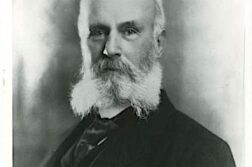EVERY LANGUAGE makes assumptions and embodies biases so deeply embedded as to be invisible to its speakers. Every so often a cultural prejudice of this kind comes to light, as when people began to point out that English and many languages take for granted a gender dualism that’s typified by the third-person singular pronouns “he” and “she.” People who had once been silenced by this prejudice began to assert that this binary language did not correspond their sense of themselves as human beings.
This awareness has fanned out to a larger public. In recent years a number of celebrities have come out as not completely man or woman, including Sam Smith, Ruby Rose, and Jonathan Van Ness. The increased awareness is allowing more people to recognize and name the way they feel. When people can discuss their shared experiences, they can invent the language that allows them to explain and label their identities.
In the 1970s, the word “bigender” was coined to describe people who identify with both binary genders. The word “genderqueer” was first used in 1995 for people who don’t identify as “man” or “woman” as conventionally understood. People who don’t have a gender can call themselves “agender,” a word first popularized in 2006. Those who identify as somewhere between the two standard genders can use “demigender,” the use of which has been increasingly common since 2014. These identities are all broadly covered by the umbrella term “nonbinary.”
Because the vocabulary used to describe these identities is new, the phenomenon itself may appear novel. But people have lived outside the gender binary throughout human history. One example is the Public Universal Friend, who lived in the U.S. at the end of the 18th century. The Friend eschewed gender after a near-death experience and asked not to be referred to by any gendered pronoun.
Over 200 years later, nonbinary people still struggle to find pronouns that feel right for them. While some nonbinary people may be able to work with “he” and “she,” the basic third-person singular pronouns in English, many reject these pronouns as inadequate to describe their experience. There are also people who identify exclusively with one of the binary genders but who don’t want to use gendered pronouns for personal or political reasons. Some radical feminists who believe that the social constructs of gender should be dismantled may choose to use genderless pronouns to represent this belief. In an op-ed piece in The New York Times, Farhad Manjoo asked to be referred to by non-gendered pronouns, arguing that the use of the standard pronouns tends to reinforce gender biases and assumptions.
Irrespective of their reasons, people who don’t want to be referred to by the gendered pronouns available in their language must find other pronouns to replace them. Sebastian McGaughey’s essay “Understanding Neopronouns” in these pages (March-April 2020) elaborated some of the alternatives to “he” and “she” that have been proposed for English usage. The most common approach is to use the plural form “they,” which is non-gendered in English, but new sets of words to replace “he, him, his” and “she, her, hers” have also been put forth.
Kim Barrett (they/their) lives in Oxford, UK, and writes about sexuality, mental health, and the environment.







Discussion1 Comment
As a nonbinary person who has struggled greatly with pronouns, I appreciate this quite complete overview. I didn’t feel left out. I’m still struggling with the mystery that while “he/him” is the best fit for cisgendered me when referring to myself, and I present as male, I reject a lot of the stereotypical gender expectations of such a designation.